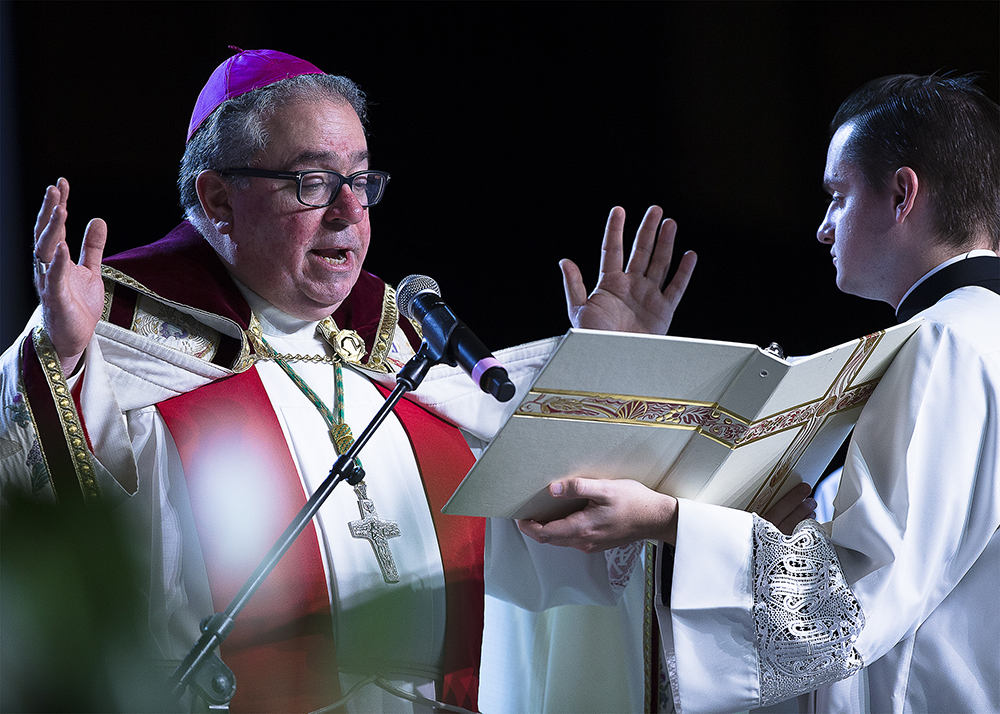
(Photo: CNS/Tyler Orsburn)
By John Lavenburg, National Correspondent
HARTFORD, CONN. — Bishop Michael Olson of Fort Worth wants people to consider three questions regarding the use of social media: does this need to be said? Is it my place to say it? And am I saying this in a way that builds up or tears down?
Through those questions, Bishop Olson sees an alternative to the usual Lent sacrifice of online mediums like Facebook and Twitter.
In fact, Bishop Olson, along with other bishops and priests, advises against a six-week social media purge.
“I’m not so sure we need to do that, especially since that is a means by which the world is trying to communicate,” Bishop Olson said.
Social media has contributed to division in the country, and the formats often limit real dialogue. But at the same time, Catholic leaders use it to evangelize, connect with parishioners and spread the faith messages.
Pope Francis sends out daily tweets to over 52 million followers from at least nine different Twitter accounts, all in different languages.
Prelates across the United States commonly reach thousands, in some cases hundreds-of-thousands, of people through Twitter.
Bishop Olson shares messages with almost 7,000 followers on his Twitter account. Bishop Nicholas DiMarzio of Brooklyn reaches nearly 10,000 people across multiple platforms.
Bishop DiMarzio recognizes both the positives and negatives of social media.
It’s positive in the sense that it can be “a real means for spiritual growth” but negative when people get lost in it.
“Too much of anything is not good, but if you can use it with discernment, you can use it at targeted times,” Bishop DiMarzio said. “Sometimes we know somebody is hurting, or somebody had a problem and we contact them on social media and that can be helpful. That’s good work for Lent. So, it’s not something that’s in itself bad. It’s how we use it.”
“The goal is to free ourselves from useless things so we can concentrate on important things, and that’s our relationship to God, and that’s what Lent’s about.”
Bishop Felipe Estévez of St. Augustine added that through the pandemic, Facebook is the way he reaches younger family members. He said people shouldn’t be “dismissive of it because it’s an advancement in the way of communication.”
One thing Bishop Estévez suggests, however, is that people continue to seek direct human contact within the COVID-19 safety protocols.
Another reason the prelates advise against nixing social media is that live-streaming on platforms like Zoom has become central to evangelization since the start of the pandemic.
It doesn’t look like that will change any time soon.
Most churches are now outfitted with video equipment so people can tune into Mass from home every week.
Especially with over ten months of refinement, as Father Patrick West from St. Sebastian Catholic Church in Queens notes, they’re “lightyears” ahead of where they were.
Bishop Olson said livestreaming allows them to connect with people that can’t come to Mass, but also people who weren’t coming to Mass before the pandemic.
“It’s a way for them to be present and also a way for us to be aware of them without offering it as a replacement for the obligatory participation and presence at Sunday Mass,” Bishop Olson said.
It can have a similar impact on religious education, Bishop Olson added.
“Things like Zoom and livestreaming can reinforce what we’re doing already with in-person formation and catechesis. It’s a way we can reinforce what we’re teaching in the presence of the family and catechizing the whole family,” he said.
For Father Michael Callaghan of Assumption of the Blessed Virgin Mary in Brooklyn, social media should be part of a broader reflection people should take for Lent that doesn’t need to include sacrifice.
“I don’t know that people need to give up a whole lot right now,” Father Callaghan said. “I think what they need to do is choose how they use their time, how they use their technology, and how they reach out to one another in a way that’s as personal as possible.
“That will help us start laying the ground for how we’re going to re-connect after pandemic living is done.”
